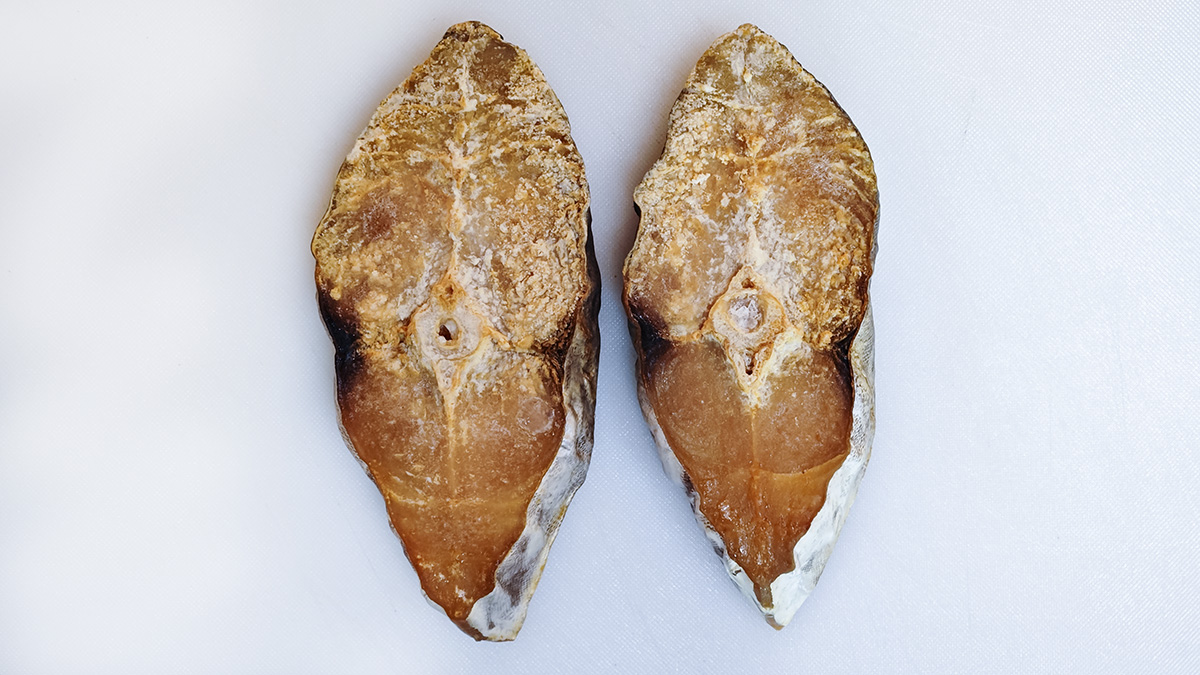Clem's
Salted Fish
Many ethnic cultures millennia ago, learnt how to preserve perishable foods, including catch from the sea. And so did the Chinese. In Southern China, two types of salted fish are made: a salt-seasoned, firm-flesh variety (Sat Yuk in the Cantonese language), and a fermented, soft-flesh variety (Mui Heung in the Cantonese language). Salting fish not only preserves the product but the process imparts flavours developed during the transition of fresh tissue into a moisture-reduced product (reduction in Water Activity, Aw to deter microbial growth). Development of a distinct flavour profile is especially true in the case of Mui Heung whereby fermentation breaks down proteins and fats into a myriad of chemicals, many of which have organoleptic properties.
Those who are familiar with salted fish will know that the smell can be off-putting but the taste delectable (akin to the reaction of some people to the Durian). However, there has been some scientific evidence that some breakdown products (particularly N-nitroso- compounds) in salted fish may be involved in the etiology of nasopharyngeal cancer1 although there is also evidence which suggests a less alarmist conclusion2 which included stating that: "Hard and soft salted fish have different risk profiles. Salted fish and other preserved foods were at most weak risk factors for NPC in all periods and may play a smaller role in NPC occurrence than previously thought." It is currently generally agreed that salted fish products should not be fed to growing children. Nevertheless, as is true with ALL foods, eat with moderation and choose your foods wisely. I still enjoy salted fish once in a while.
Here is how I made a small batch of Min Heung and Sat Yuk salted fish:
INGREDIENTS
-
Fish steaks
I chose Mackerel; 4 steaks amounting to a bit less than 1 kg in total. -
Coarse salt.
METHOD
-
Wash and pat dry the fish steaks.
-
Liberally salt the top and bottom of the steaks as pictured below:

Mackerel steaks
salted at Day 0
-
For Min Heung style fermented fish:
-
Wrap each salted steak tightly with plastic wrap.
-
Place the wrapped steaks in an airtight box.
-
Store at room temperature for 3 weeks.
-
After 3 weeks carefully remove from the container (the steaks may be quite soft), pat dry, coat with more salt and then air-dry / sun-dry until the fish is firm.
-
When firm enough to your liking, the fish is ready.
-
Store dry in a refrigerator.
-

Min Heung method:
The fermented and salted mackerel steaks after 12 hours dehydration at
50°C
METHOD
-
For Sat Yuk fish:
-
Place the salted steaks in a container.
-
Leave the steaks in the refrigerator for some 3 days.
-
After 3 days, pat dry the steaks and leave in a well-covered but airy container (say a colander covered with cloth to keep out vermin) and air-dry / sun-dry for a few days until the fish is firm.
-
When firm enough to your liking, the fish is ready.
-
Store dry in a refrigerator.
-

Sat yuk method:
The mackerel steaks after 12 hours dehydration at 40°C
and three weeks air drying
-
IARC Working Group on the Evaluation of Carcinogenic Risk to (2012). CHINESE-STYLE SALTED FISH. International Agency for Research on Cancer.
-
Donal, B. et al. (2019) Past and Recent Salted Fish and Preserved Food Intakes Are Weakly Associated with Nasopharyngeal Carcinoma Risk in Adults in Southern China. The Journal of Nutrition 149(9): 1596 - 1605.
25 July 2024
Created by Clem Kuek
